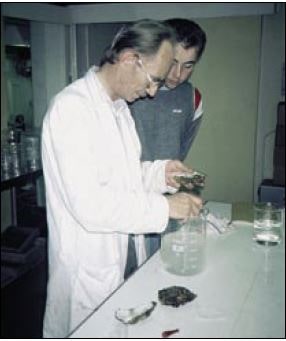4.2.2 Gamete stripping
Fully mature gametes can be “stripped” (removed) from the Pacific oyster, Crassostrea gigas, the American (Eastern) oyster, Crassostrea virginica, the mangrove oyster, Crassostrea rhizophorae, and from other similar oviparous oyster species. This is a common and convenient way of “spawning” these species following a suitable period of conditioning.
This procedure involves sacrificing a number of ripe adults when larvae are required (Figure 39). Removing the flatter shell valve reveals the soft body tissues of the oysters. The gonad overlies the digestive tissues towards the umbone and hinge of the shell and when very ripe will extend around the adductor muscle. Either the gonad can be cut repeatedly with a scalpel and the exhuding gametes washed with filtered seawater into a part-filled beaker or bucket, or a clean Pasteur pipette can be inserted beneath the overlying gonad epithelium and the gametes removed by exerting gentle suction. The pipette contents are then transferred to a beaker or bucket containing

Figure 39: Stripping and transferring gametes from Pacific oysters to a beaker of filtered seawater using a Pasteur pipette.
seawater at culture temperature. In both cases, a small sample is first removed from each of the number of opened oysters. These samples are examined microscopically under x40 to x100 magnification to determine sex and the appearance of the gametes. The sperm should be motile and the eggs, which are normally pear-shaped when first removed, should round off in contact with seawater within 20 minutes. The top shell valves should be replaced on the oysters to await stripping in order to prevent dessication.
Assuming the gametes are fully mature, the process is continued to remove gametes from the opened oysters – whose sex is now known – starting first with the females. Crassostrea oysters are extremely fecund. Seventy to 90 g females may each be carrying 80 to 120 million eggs, not all of which need to be stripped.
Care needs to be taken to prevent puncture of the digestive gland during stripping. This is to avoid contamination of the gametes with tissue and bacteria and other micro organisms of gastro-intestinal origin. Either the eggs of individual females can be collected separately in clean 2 to 5 l glass beakers or they can be pooled together in 10 to 20 l plastic buckets that are 75% filled with filtered, ultra-light disinfected seawater at the required temperature (usually 24+2oC).
After completion of egg stripping, the males are dealt with in a similar manner. The exception is that it is more common to pool small samples of the sperm from each of the males in a 1 l glass beaker, part filled with filtered ultra-light disinfected seawater at the same temperature, making sure that the final sperm density is not too great. As a guide, one should just be able to see nearby objects through the beaker and its contents. The gametes are then ready for fertilization.